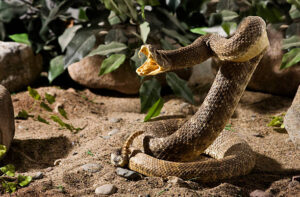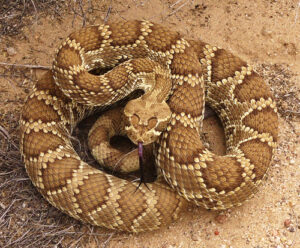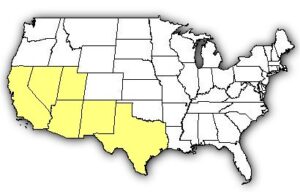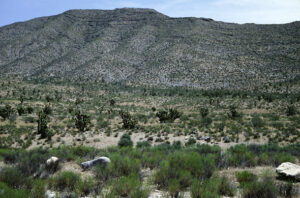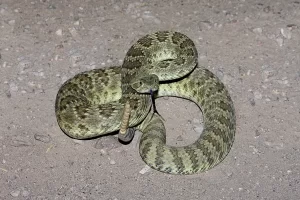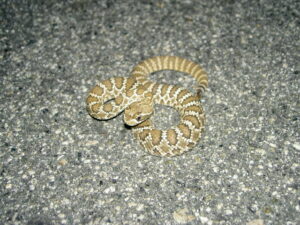The Mojave rattlesnake, also known as Mojave green, is a highly venomous, heavy-bodied, medium-sized pit viper species living in the deserts of central Mexico and the southwestern United States. Its neurotoxic-hemotoxic venom is considered to be the most potent rattlesnake venom. It is most active from April to September and brumates alone or in small groups in winter.
Scientific Classifications
- Suborder:Serpentes
- Family:Viperidae
- Genus:Crotalus
- Species:C. scutulatus
Conservation Status
Subspecies
This snake has two recognized subspecies.
- Huamantla rattlesnake (Crotalus scutulatus salvini)
- Mojave rattlesnake (Crotalus scutulatus scutulatus)
Description
Size
On average, the snake grows to a length of less than 3.3ft (100 cm), with a maximum size of 4.50ft (137.3 cm).
Color and Appearance
Its color varies from shades of brown to pale green, depending on the surroundings. In some places, their green hue has led them to be referred to as Mojave greens. It looks like the western diamondback rattlesnake (C. atrox) with a dark diamond pattern running down its back. However, the white bands on the tail tend to be wider than the black, while in the case of C. atrox, they are almost the same width. Plus, The Mojave green has enlarged scales on top of its large triangular head between the supraoculars with a light postocular stripe passing behind the corner of the mouth. On the other hand, C. atrox has its crown covered with small scales, and the said stripe intersects the mouth.
Are They Dangerous to Humans
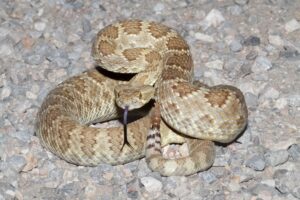
The Mojave rattlesnake is known to be aggressive around people and defends itself vigorously if disturbed. The most venomous rattlesnake has both neurotoxic (nervous system and brain damaging) and hemotoxic (tissue and muscle destroying) venom that is considered one of the deadliest of all rattlesnakes, even matching several elapids. However, chances of survival are reasonably good if medical attention is given soon after the bite.
Significant envenomations can cause difficulty speaking and swallowing, vision abnormalities, etc. In severe cases, skeletal muscle weakness can result in difficulty in breathing and even respiratory failure. Contrary to popular belief, deaths due to its bite are uncommon, which can be attributed mainly to the wide availability of the antivenom.
Mojave Rattlesnakes at a Glance
Distribution
This snake is found in the US in southern California, northern, eastern, and southern Nevada, most of Arizona, extreme southwestern Utah, some of Texas, and southern New Mexico. Its range also extends southward through a major part of Mexico to southern Puebla.
Habitat
It lives in deserts and other places with xeric vegetation from sea level up to 2500 m elevation. The snake of lower mountain slopes and high deserts is often found near scrub brush like mesquite, creosote, and sage. But it can also live in lowland areas with sparse vegetation in Joshua tree forests, grassy plains, and among cacti. It prefers open, arid habitats and tends to avoid rocky and densely vegetated areas.
Lifespan
The average lifespan of the pit viper is 12.5 years, and it lives for almost 20 years in captivity.
Predators
It is preyed upon by roadrunners, mammals and birds of prey, and other snakes like the California kingsnake.
Diet
The ambush predator mostly eats lizards and small rodents. A pair of heat-sensing pits located between the eyes and nostrils is a useful adaptation that helps the snake locate its prey even in the dark.
Reproduction
Ovoviviparous (gives birth to live young from eggs that hatch inside the body)
They give birth to 2-17 young (8 on average) in a brood from July through September.
Similar Species
The black mamba, Dendroaspis polylepis, is larger, faster, and has more potent venom than the Mojave rattlesnake. The former also looks different, with no diamond pattern on its body.
Source
inaturalist.ca, istockphoto.com, earth.com, venombyte.com, flickr.com, kingsnake.com, depositphotos.com


